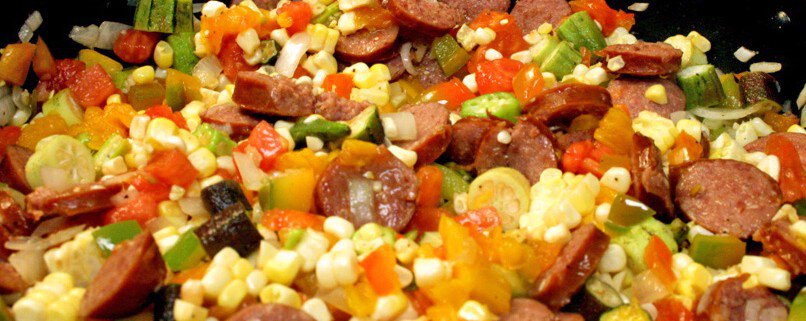Here is another great recipe that takes advantage of the abundance of fresh vegetables out there now. This is an easy, foundational salsa recipe that is extremely tasty just as it is, but also lends itself very well to experimentation with whatever fresh vegetables you have available. Everything is roasted to bring out the fullness of the flavors, and to help them mingle better. I’ve been able to do an acceptable substitute in the winter with fresh frozen chiles from our garden, and canned Italian plum tomatoes!
This is one of those salsas that just grabs you by the taste buds and gets your attention. No matter if it is mild or hot, you keep coming back for “one more bite”, because it just tastes so good. When having guests over, a batch rarely lasts through the evening, when it’s at the height of its warm, rich goodness. Best cooked outside, this lends itself beautifully to doing fresh quesadillas, queso fundido, burgers or all three in succession on the grill, along with plenty of cold beer and good friends. Watching the late summer sun going down after a hot day and enjoying the salsa along with other great food is one of the memories that will be brought up many times.
I like using several kinds of chiles, some mild, medium and hot to bring more depth of flavor to my salsas. I will start picking the mild ones, fewer of the medium, and less still of the hotter ones. This builds a base of flavor first, then heat. Don’t worry if it looks like you’re making tomato soup when you start roasting the tomatoes, everything will turn out just fine…
Roasted Fresh Garden Salsa
2 Lbs fresh tomatoes-diced. Plum tomatoes are best, but use what is fresh- a couple of different kinds will give more depth of flavor! Dicing will help remove some of the excess juice.
3-4 Ripe red bell peppers– diced
10-15 Various Chiles to taste for heat- de-seeded, de-veined and diced
3-4 Ears fresh sweet or roasting corn– cut from the cob. About 1-2 Cups
5-6 Cloves garlic- sliced in 1/8 inch slices
1-2 Cups cooked Black beans (optional)
1 Tsp whole Cumin
1/2 Tsp whole Coriander
1/4 Cup Extra Virgin Olive Oil
1 Tsp salt
1/2 Tsp fresh ground black pepper
Splash of Balsamic Vinegar
You’ll need a couple of large, heavy, shallow pans for roasting- preferable cast iron, as it retains the heat well and is easy to keep at the best temperature for roasting vegetables. The grill or outdoor stove is the best place to do the cooking, as the heat stays outside, and you get to enjoy the late afternoon! A couple of large bowls to hold the roasted vegetables and a large food processor or blender will be needed after everything is roasted.
Heat the pans to a medium heat, add the tomatoes to one pan, the bell peppers and corn to another, and if you have a third pan- the Chiles to that one. Let them roast until their skins start to turn dark. The skins should be a little black in spots and starting to loosen from the fruit. This can take up to a half hour depending on the heat of your grill or stovetop. Stir and turn with a wooden spatula occasionally. You will see some sticking, especially with the tomatoes- this is ok. When the Chile skins are starting to turn dark, add the garlic to that pan. Remove the veggies when they are fully roasted and have dark skins with a few black spots on them. The corn should have a dark yellow color to it. Put them all together into a large bowl and cover.
Toast the cumin and coriander in a small heavy pan over medium heat for 2-5 minutes, until they release their aromas. You will see the seeds start to darken and release their aromas- move the pan off of the heat for a second or two, then return to the heat. Continue this until the rich toasted aroma tells you they’re ready. Grind in a mortar and pestle or spice grinder to a coarse ground consistency.
Add the vegetables to the food processor in batches if needed and process with a chopping blade until a chunky consistency is reached. Do not over process to a smooth or fine consistency- you will lose flavor. Repeat until all the vegetables are processed, and return to a large serving bowl. Add ground spices, Olive Oil, salt and ground black pepper. Add splash of Balsamic Vinegar and mix well. Taste and adjust salt and pepper if needed.
Serve warm with chips, or in and on top of fresh hot quesedillas or accompanying queso fundido with chips.


